Ivan Jurić Coaching Style
Atalanta‘s been a true revelation to the football world in the past few years.
The club from Bergamo broke new heights this season,
finishing in the top four again, more confidently, in Serie A and reaching the quarterfinals of the Champions League, where they will facePSG.
Their recent rise can be attributed to the brilliant coach Gian Piero Gasperini and their academy, which allowed them to reinforce the squad consistently.
Gasperini’s methods of work and entire football philosophy influenced many players and people who worked with him over the years, including the present coach of Hellas Verona, Ivan Jurić.
He worked with this mentor at Inter and Palermo, starting his managerial career shortly after.
Jurić promoted Crotone to Serie A for the first time in their history and then had three coaching spells with Genoa.
The coach’s first success on a big stage happened this season as a manager of Hellas Verona.
At the end of the campaign, the newly promoted side finished ninth in the table.
The Croatian manager got the opportunity to instil his style of play for Hellas Verona, which Gian Piero Gasperini largely influences.
However, the head coach made tactical tweaks due to his club’s position and existing roster.
In this tactical analysis, we will delve into Ivan Jurić tactics and style of play.
We will try to see how this team’s playing style differs from that of the current Atalanta side and what the future holds for the Gialloblu.
Ivan Jurić Pressing Style At Hellas Verona
Hellas Verona is third in the league in terms of PPDA, with 9,28 passes, only behind Bologna and Atalanta.
Just like Gasperini, Jurić opts for a man-marking approach in the defensive phase.
However, his side presses less aggressively in the attacking third, preferring compactness between the lines to aggressive pressing.
High pressing happens only after specific triggers, backward passes, and the cases of a more static build-up.
On other occasions, Hellas Verona fell back into a mid-block and put pressure in the middle third.
Within their man-oriented approach, Hellas Verona has several pressing patterns against different formations, and they heavily depend on the tactics of both teams and the game state.
In the following few paragraphs, I will outline the main pressing principles of this team.
Throughout the season, Jurić used a 3-4-3 formation, with Günter, Kumbulla, and Rrahmani at the heart of the defence, Lazović and Faraoni as left and right wing-backs, and Veloso with Amrabat in a double pivot.
Hellas Verona’s attacking group of two interior forwards and a striker wasn’t as consistent and underwent many changes; still, Eysseric, Borini, and Di Carmine can be named as the main options.
Ivan Jurić rotated the team quite a lot from match to match throughout the season, but the basic set-up remained the same.
When playing against the same formation, which happened quite a lot during the season, Hellas Verona approaches pressing most only – man-marking by positions.
You can see this in the image below, with everyone marking their respective players by positions.
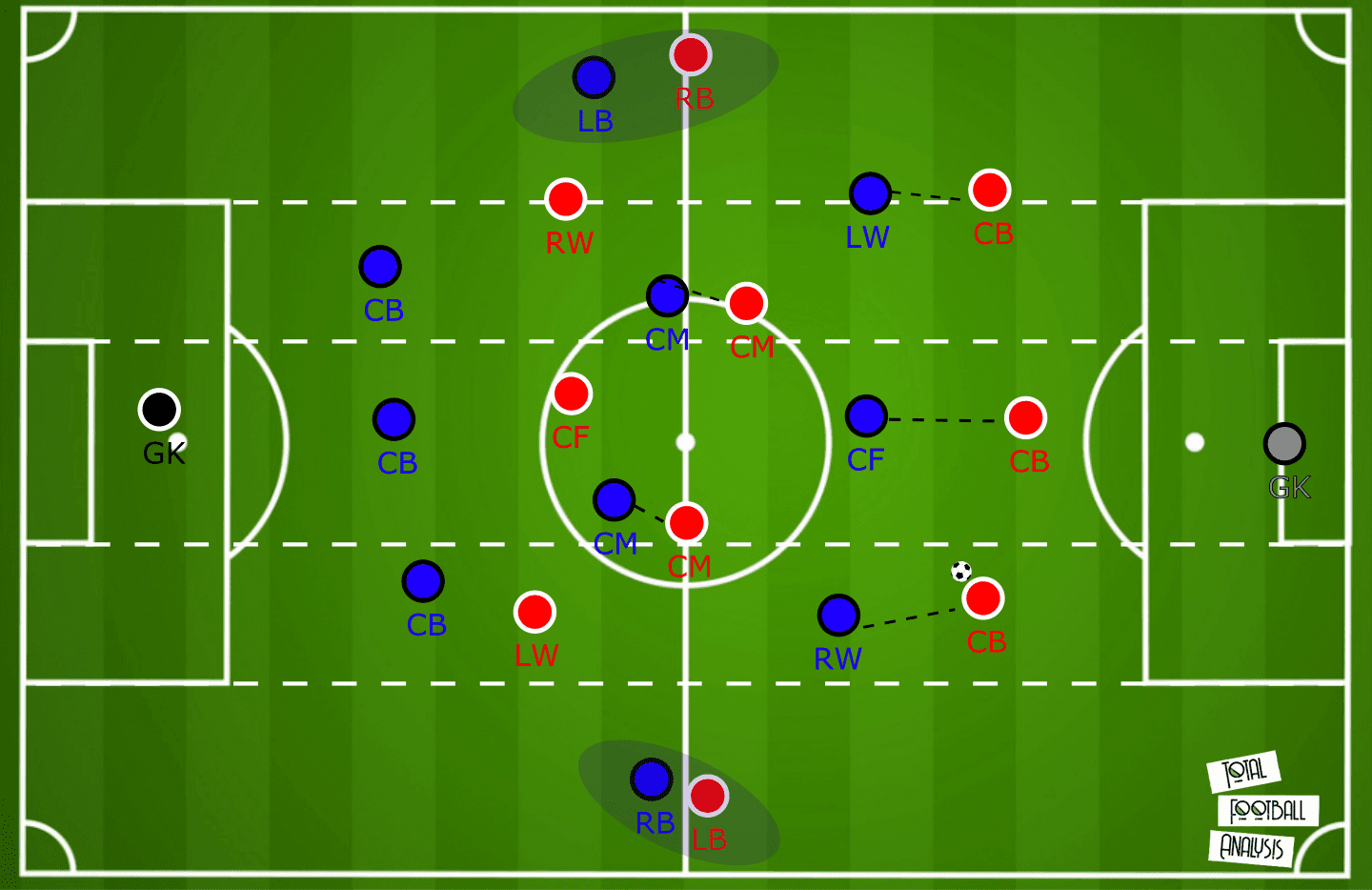
Below is an in-game example, with the front three occupying three centre-backs and two central midfielders marking their respective players.
The centre-back has to receive with his back to the opposite goal, so it’s one of the primary pressing triggers for players.
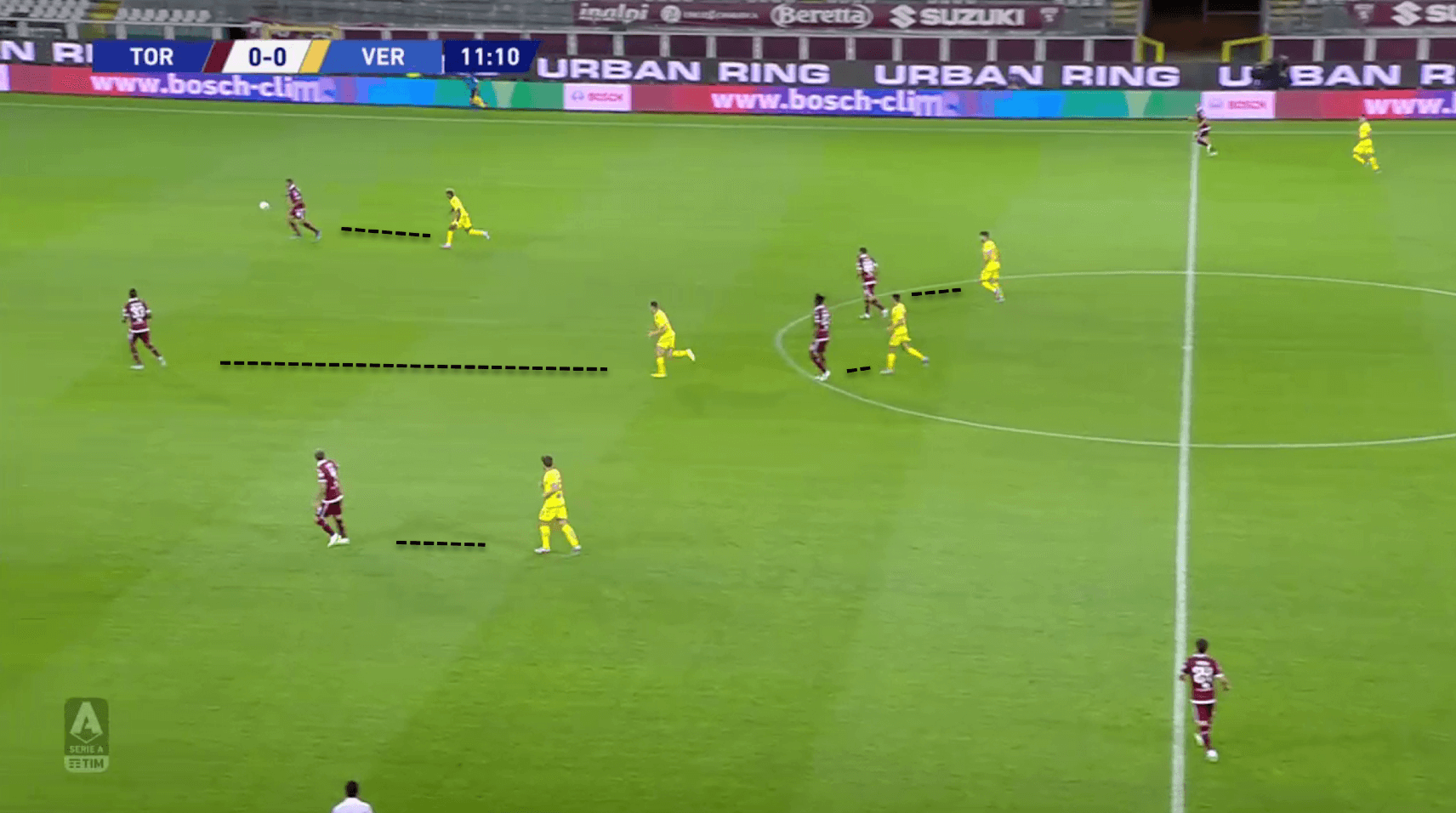
If the opposing team plays in a 3-1-4-2 attacking formation with one midfielder in a holding role, Hellas Verona can deal with it in several variations.
Ivan Jurić High-pressing: Midfielder Presses Centre-back
One of the inside forwards marks the deepest-lying midfielder, with one of the central midfielders, Amrabat or Veloso, switching on unmarked centre-back.
Hellas Verona’s centre-back then switches on, too, and marks one of the opposing 8s.
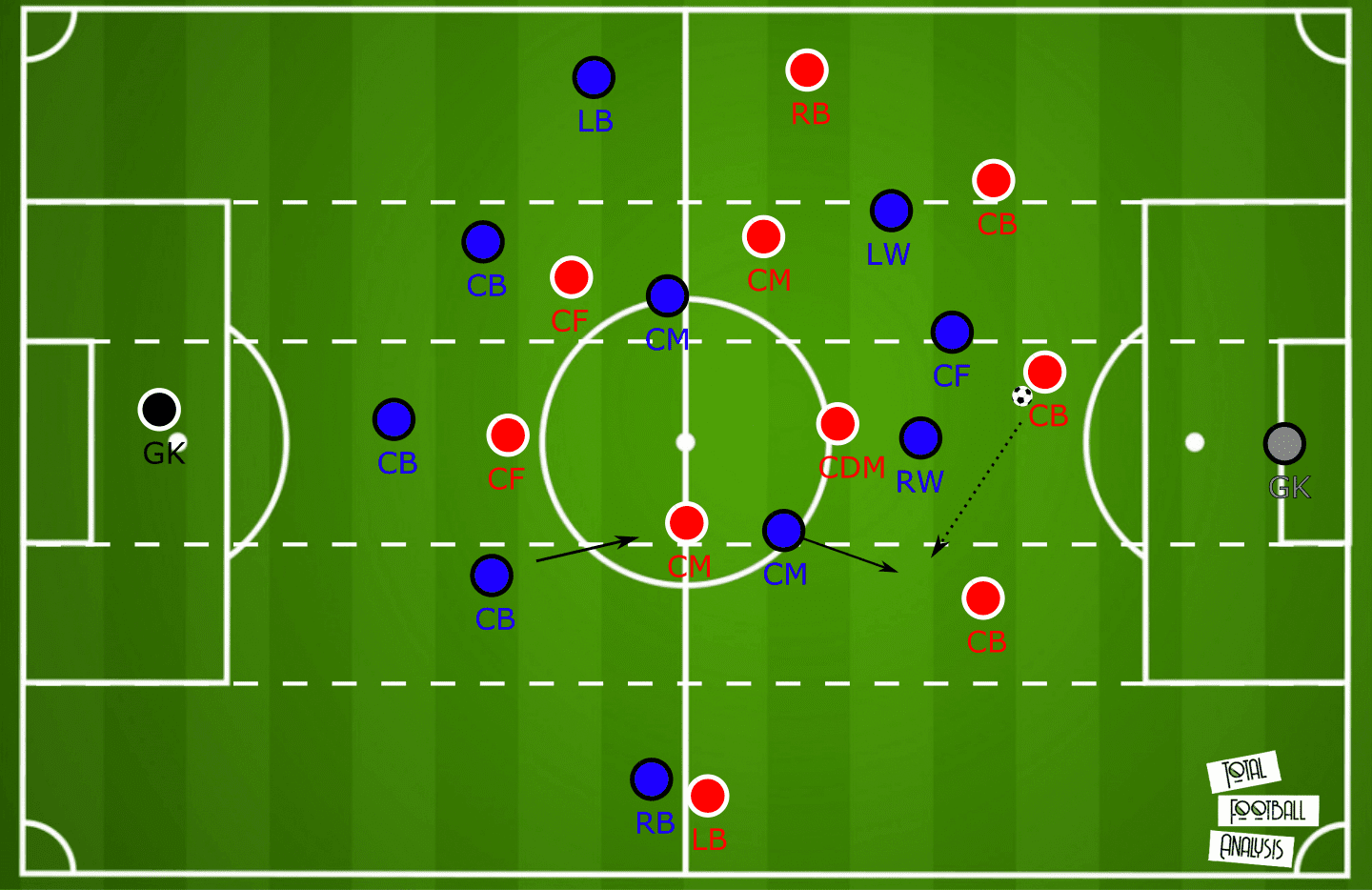
Ivan Jurić High-pressing: Midfielder Presses Defensive Midfielder
The next variation is for one of the central midfielders to mark the defensive midfielder instead, with the front three marking all the centre-backs.
Like in the previous pattern, one of the centre-backs switches to the unmarked opposing midfielder.
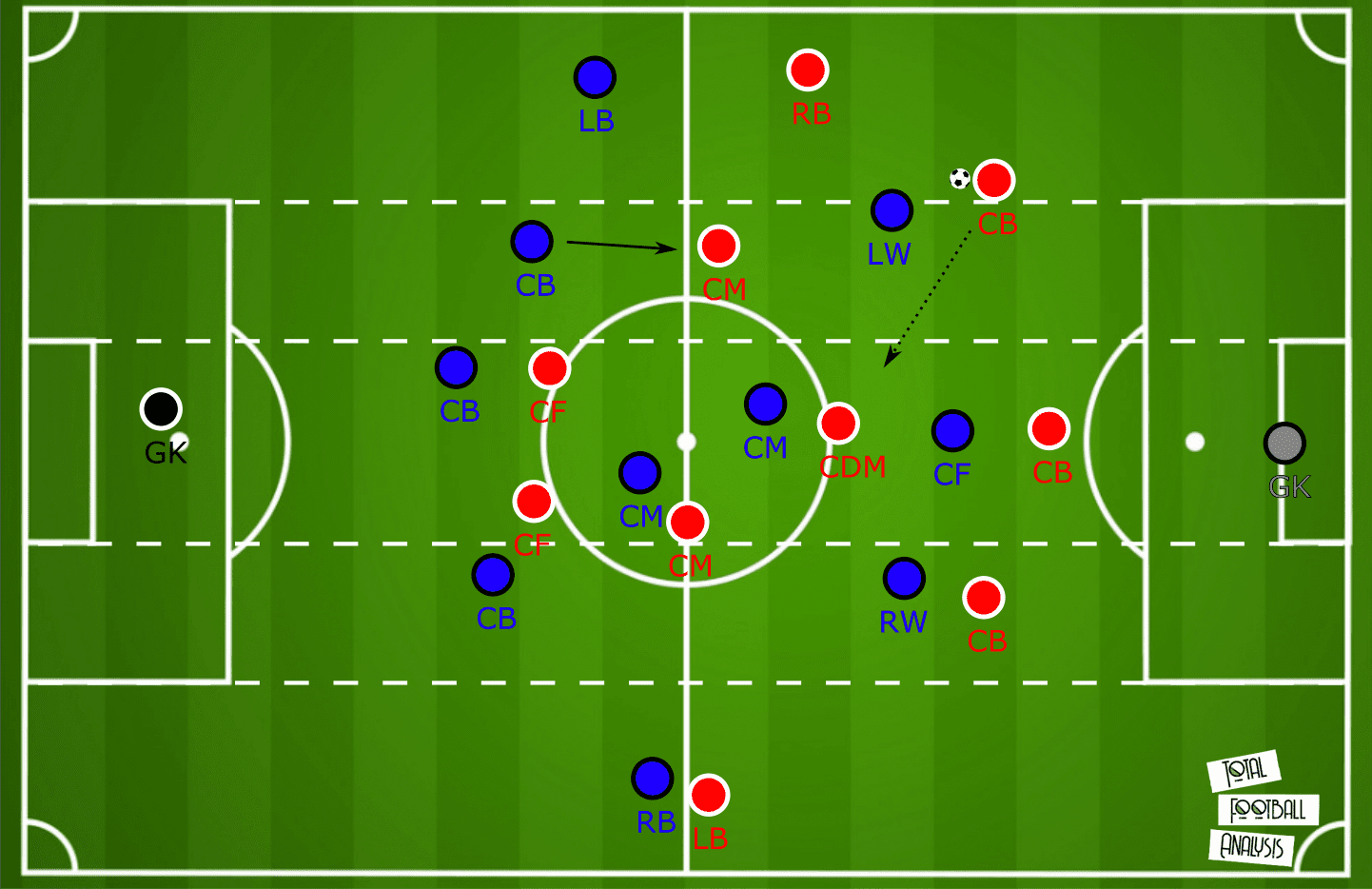
This structure was applied in the game against Lazio, with the central midfielder Pessina marking the defensive midfielder.
Lazović pushes up to his marker, who is likely to receive the pass, while another wingback sits deeper into the backline. We will discuss that in more detail.
The trigger for high press here was a back pass, with a player on the ball turning his back to the opposition goal and thus being more vulnerable to pressing.
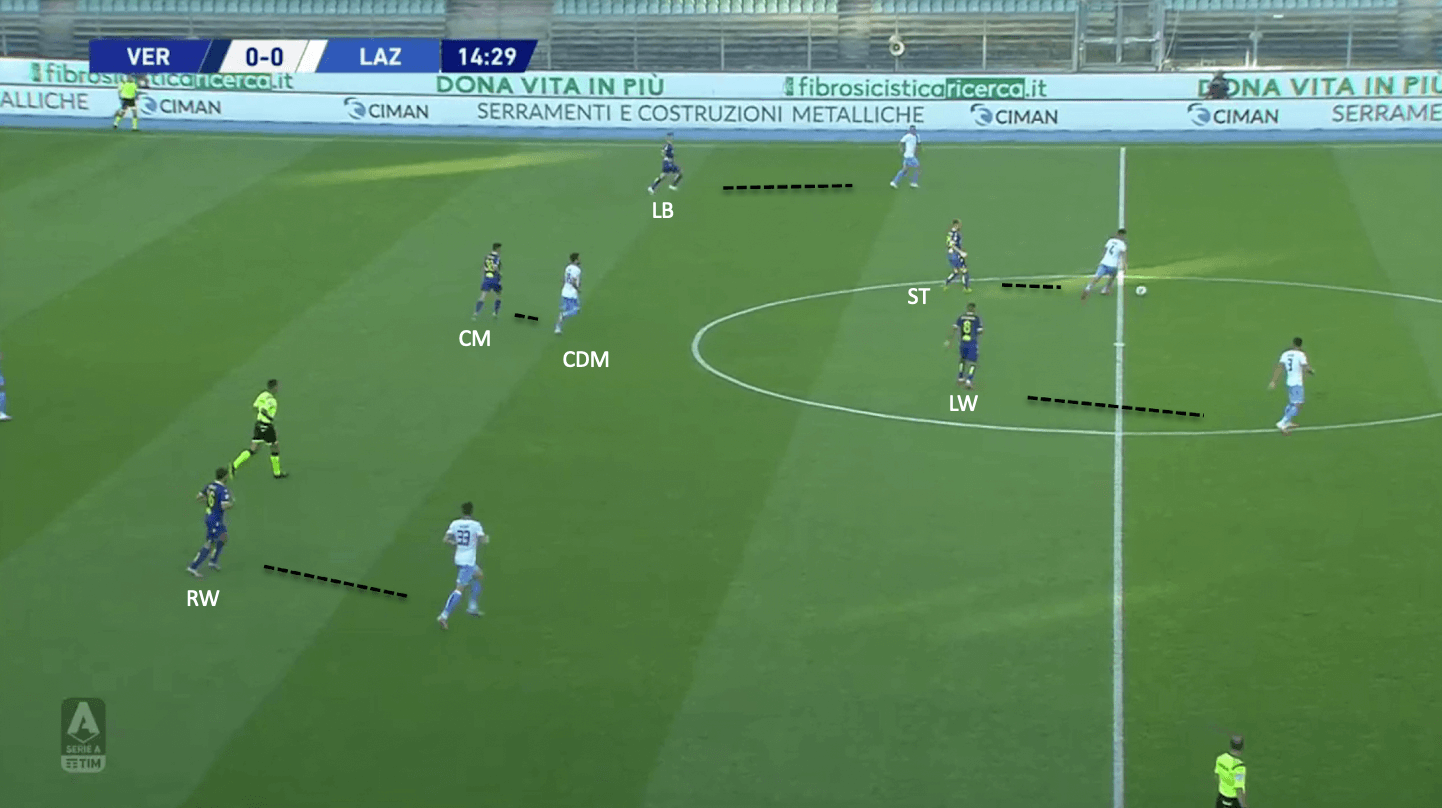
Ivan Jurić Pressing: Man-marking System
In other instances, the opponent’s numerical superiority (3v2) in the initial build-up allows them to become more compact in midfield, and this structure can still force the opposition to go wide.
In the game against Atalanta, the right inside forward and striker marked two CBs, while Veloso followed his respective marker until the last line of defence.
The third centre-back, Djimsiti(blue circle), is left unmarked, and forwards would switch on him when he receives the ball.
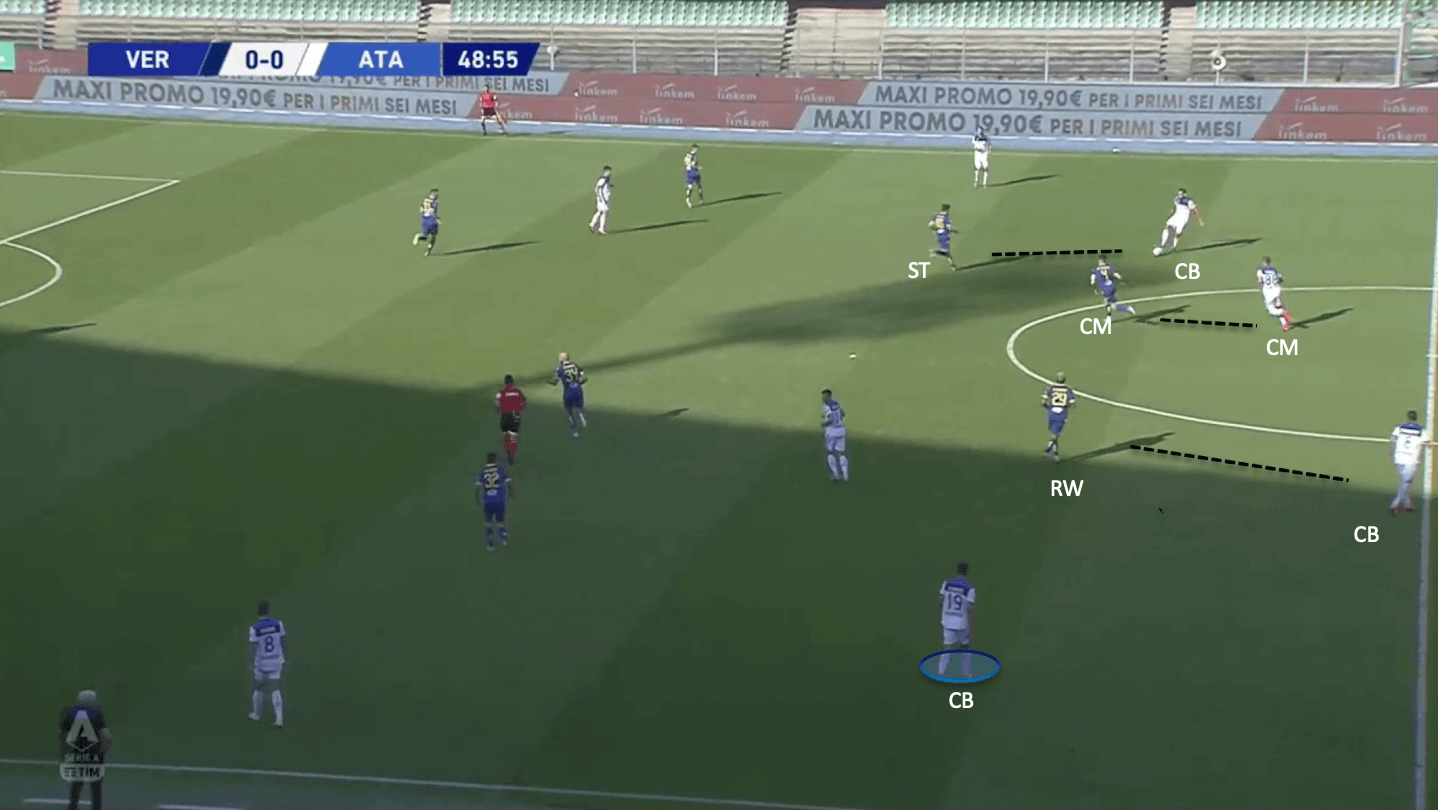
The same structure as above can be applied to opponents playing with four players at the back.
Then, one of the full-backs is left unmarked while a wing-back marks another full-back.
When an unmarked full-back receives, the wing-back pushes up to mark him, sometimes with centre-back switching on his previous marker(winger).
These pressing structures are flexible and slightly change from game to game, but the main goal is to force the opponent either to play long or forward, where CBs would step in or force them wide, where the flank trap is created.
Hellas Verona actively uses flank overloads as their primary tool in attack and defence. In the latter case, high mobility and aggressiveness allow them to win the ball back, creating 1v1 situations wide.
The wide centre-back, wing-back, central midfielder(s), and inside forward all move to one flank to limit passing options and either get the ball or force a back pass.
With this strict man-marking system and the desire to force opposing team-wide, the wing-back partnership of Lazović and Faraoni becomes essential, and we’ll touch upon that in the next section of this analysis.
Ivan Jurić Tactics: Wing-backs Key Role
When out of possession, Lazović and Faraoni have to be aware of where the ball is played and react accordingly.
When the ball is played to one of the flanks, one of the wing-backs pushes up and marks his player, while the other wing-back drops back and joins the backline.
With CBs being aggressive without the ball and constantly leaving the backline, the additional cover provided by one of the wing-backs helps to sustain defensive balance.
The coordination between the full-backs becomes more critical when the ball is played to the centre.
Then, they both push up to get closer to their markers, and one of them drops deep if the ball is played to an opposite flank.
The focus on pressing and defending more actively in the middle third impacts how these two players defend against their markers.
If the ball is played to the full-back in their defensive third, Faraoni or Lazović jumps at their markers and tries to force a back pass.
In the middle third, the pattern mentioned above kicks in.
They try to pressure players when they receive the ball and coordinate their actions depending on which flank the ball is played on.
The distinction between the two becomes more apparent when we talk about their attacking contributions.
Generally speaking, Lazović is more involved in the team’s attacking play than Faraoni is.
There is a visible incline towards the left flank in attacks, and it suits both wing-backs well.
Lazović recorded three goals and seven assists in Serie A this season, while Faraoni provided five goals and one assist.
Lazović has a great dynamic with a left inside forward and can create good spots for himself for shots, deliveries or further passes.
Faraoni, on the other hand, is not as great of a playmaker, but he is exceptional at making runs into the box and arriving at the far post.
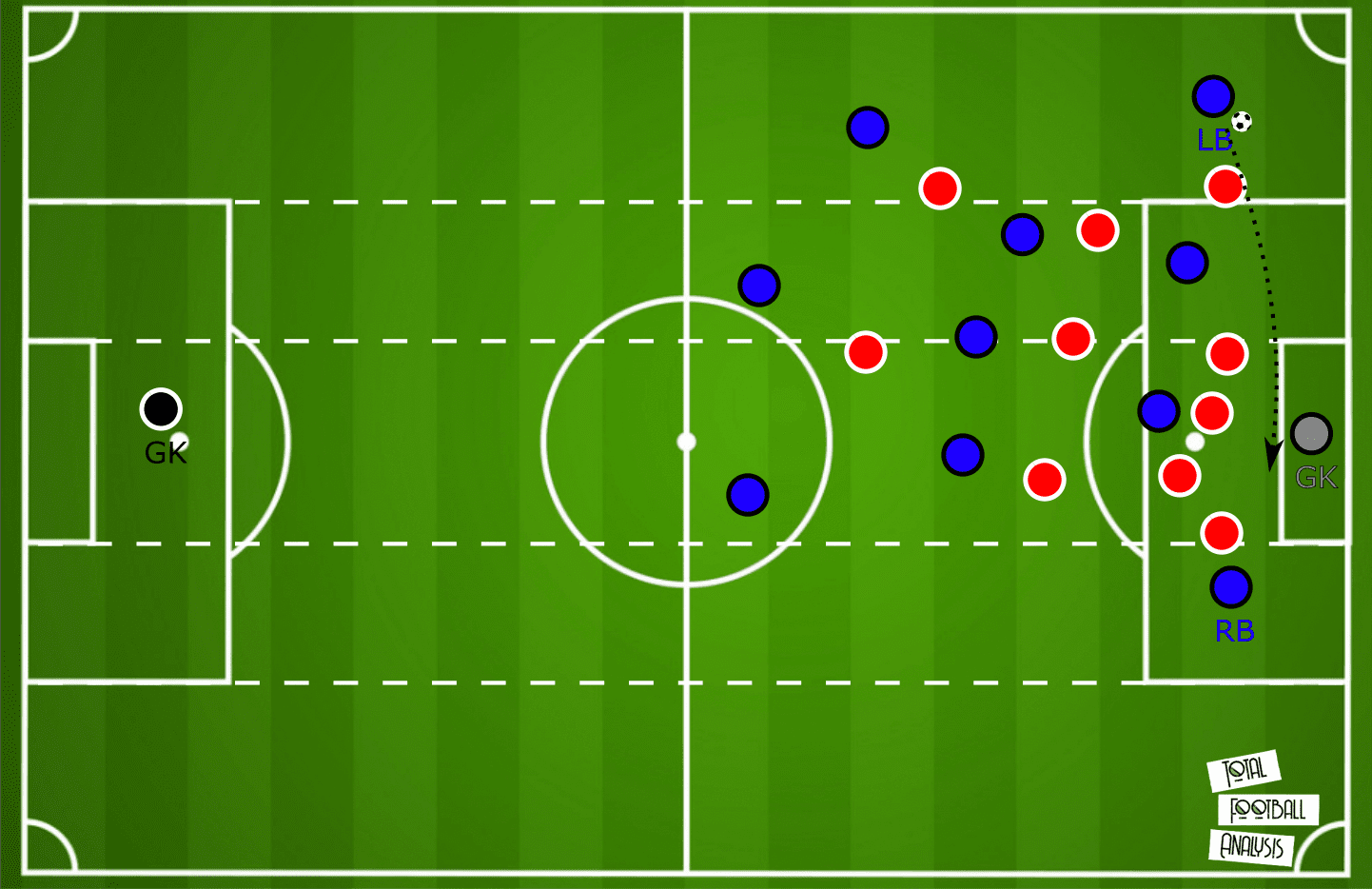
Despite the imbalance of attacking distribution, the system suits both these players’ best qualities, and it shows how the coach adapts his philosophy to his set of players.
Ivan Jurić Attacking Principles At Hellas Verona
Just like Atalanta, Hellas Verona primarily uses wide areas to progress the ball, mostly ignoring the centre.
In the build-up, the centre-backs position wide to switch flanks faster and make life harder for the first line of pressing.
Wide centre-backs’ roles include the first pass, being part of an attacking structure on the flank, and switching the play to the other flank.
Here, centre-backs are wide, and Hellas Verona looks to create a 5v3 situation on the left flank.
The concept of overload and isolate is perfectly suitable here, as Hellas Verona tries to overload one side of the pitch here, isolating Faraoni on the other.
The emphasis on attacking through wide areas and the established passing connections between players make this concept work regardless of the opposing team.
In these overloads, all general rules for ball progression apply – runs in behind, one-two combinations, third-man runs, and sometimes positional rotations, even though it is not used to the same extent as it’s done in Atalanta.
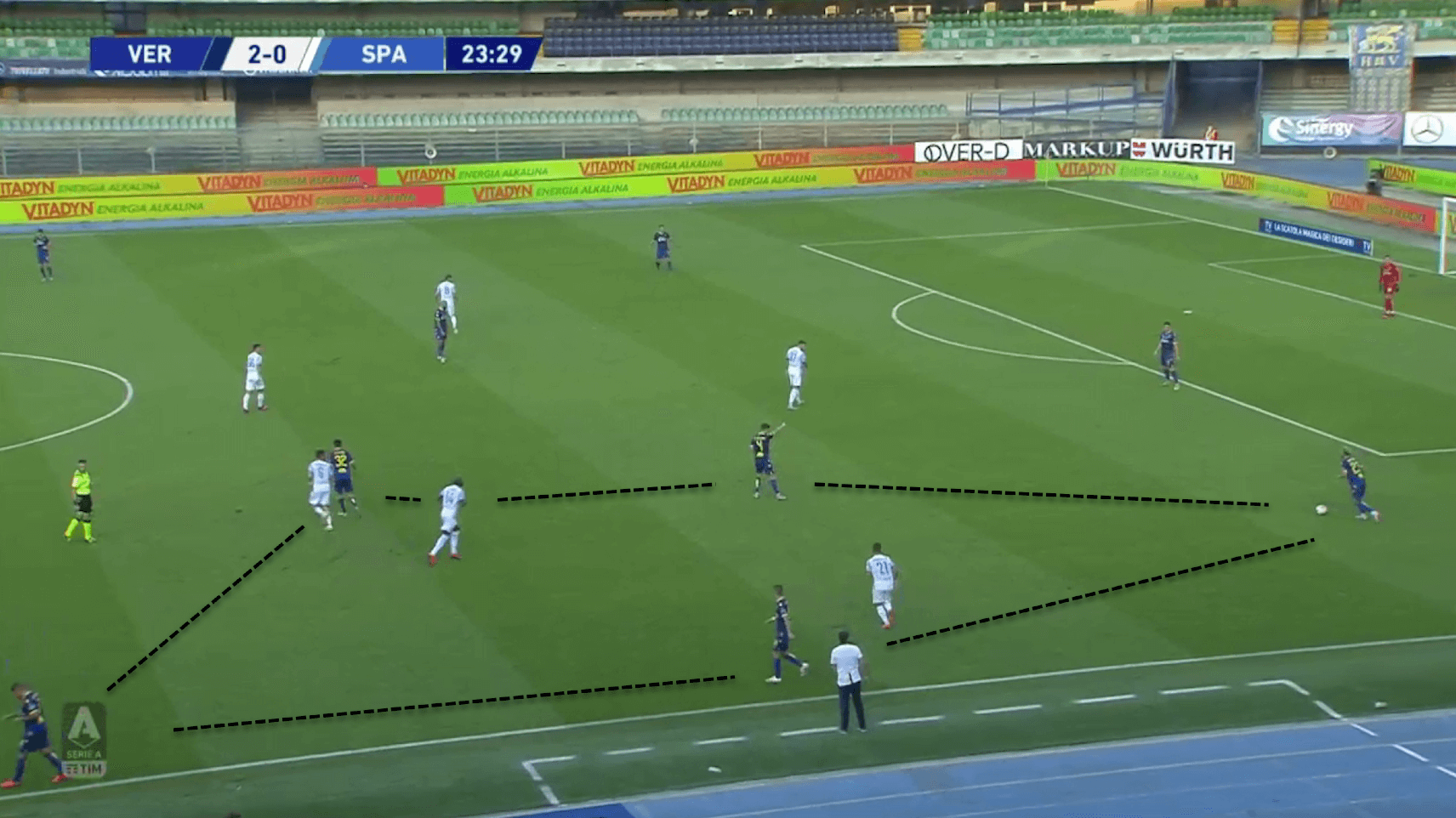
Here, Hellas Verona’s wide centre-back, central midfielder, wing-back and inside forward create an overload on one side, which can be referred to as rondo.
When creating numerical superiority wide, it’s hard for defenders to maintain good positioning and awareness of all the movements.
Thus, players tend to face a dilemma of whether to jump at players and leave the space behind open or not.
Ivan Jurić’s team well exploited both these decisions.
In this example, the inside forward, the closest player to the opposition goal, moves away his marker from the desired route for progression with his movement.
The central midfielder, who is about to receive from the wing-back, attracts pressure, too, leaving the centre-back (#23) open to run into the half-space.
Each action(pass or movement) moves the defence in a certain way, and so Hellas Verona’s style of play can play around the defence to access deeper areas.
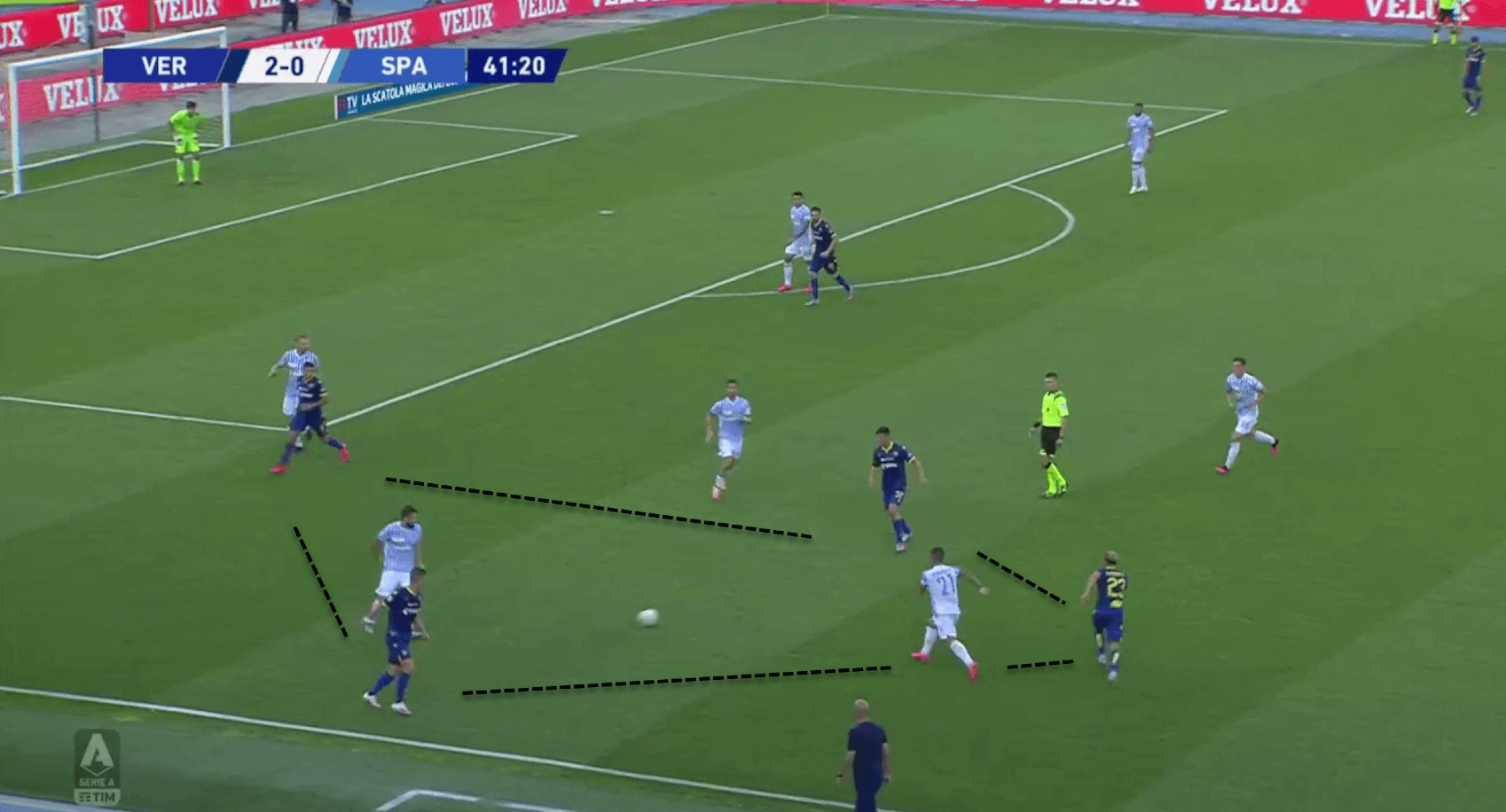
This was an example involving four players, where there are plenty of ways to move the defence around.
In other situations involving two or three players, combinations become more direct with runs in behind from an inside forward or wing-back after one-twos or third-man runs involving a central midfielder.
Hellas Verona doesn’t have a player who can constantly play between the lines, so accessing the penalty area with deliveries from the flanks is the main way for this team to create chances.
Thus, two wing-backs, Lazović and Faraoni, are essential for the team in the attacking department.
The double pivot of Sofyan Amrabat and Miguel Veloso plays a big part in the team’s attacking structure.
Their primary role is getting the ball to the flanks, either themselves or through a wide centre-back, and then helping to create wide overloads.
Both players are also responsible for redistributing the ball to opposite flanks.
They are solid under pressure when receiving with their back turned to the opposition goal, and hence, their qualities under pressure are invaluable in the build-up.
When under pressure, one midfielder drops to escape pressure, as Amrabat does in the image below.
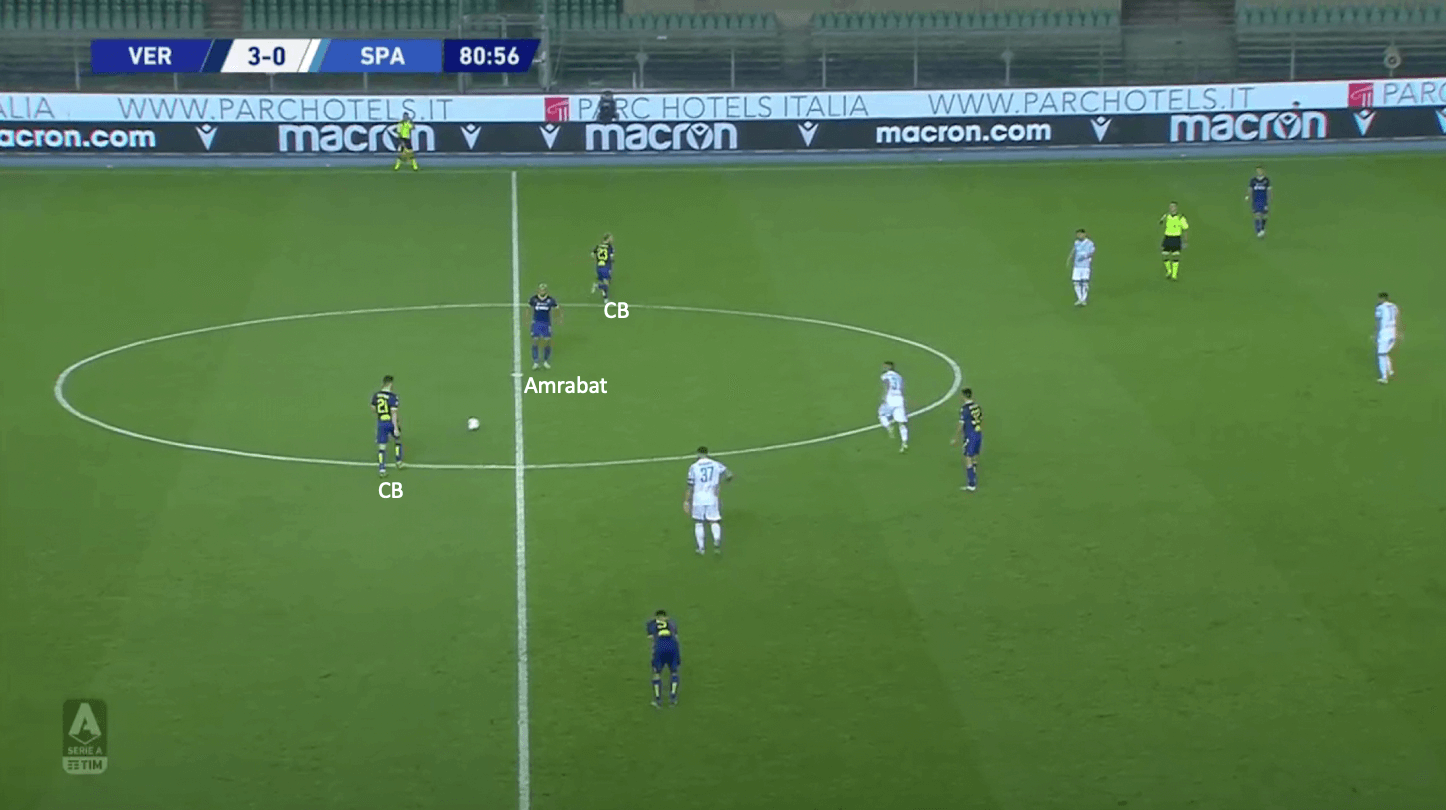
Ivan Jurić’s tactics will evolve in the upcoming seasons, and balancing out the distribution of attacks and getting a playmaker is, in my opinion, the most essential thing for this team to continue its cycle.
Conclusion
Jurić has exceptionally kept Hellas Verona afloat this season and made them battle for European places for most of the campaign.
However, to maintain this level of performance and go beyond it, as Atalanta did, they need to strengthen the squad in this transfer window.
Unfortunately, many of the core players who significantly impacted the team this season are leaving—Amrabat and Rrahmani joined Fiorentina and Napoli, respectively, and several more players await their transfers.
It’s going to be a decisive transfer window for the club’s development, and the right signings will be vital to repeating this season’s success.
Ivan Jurić’s tactics and style of play are already in place and will continue to evolve.
Given what the Croatian coach has achieved with this roster, there is a good chance we will see Hellas Verona competing for the same places in the upcoming season.

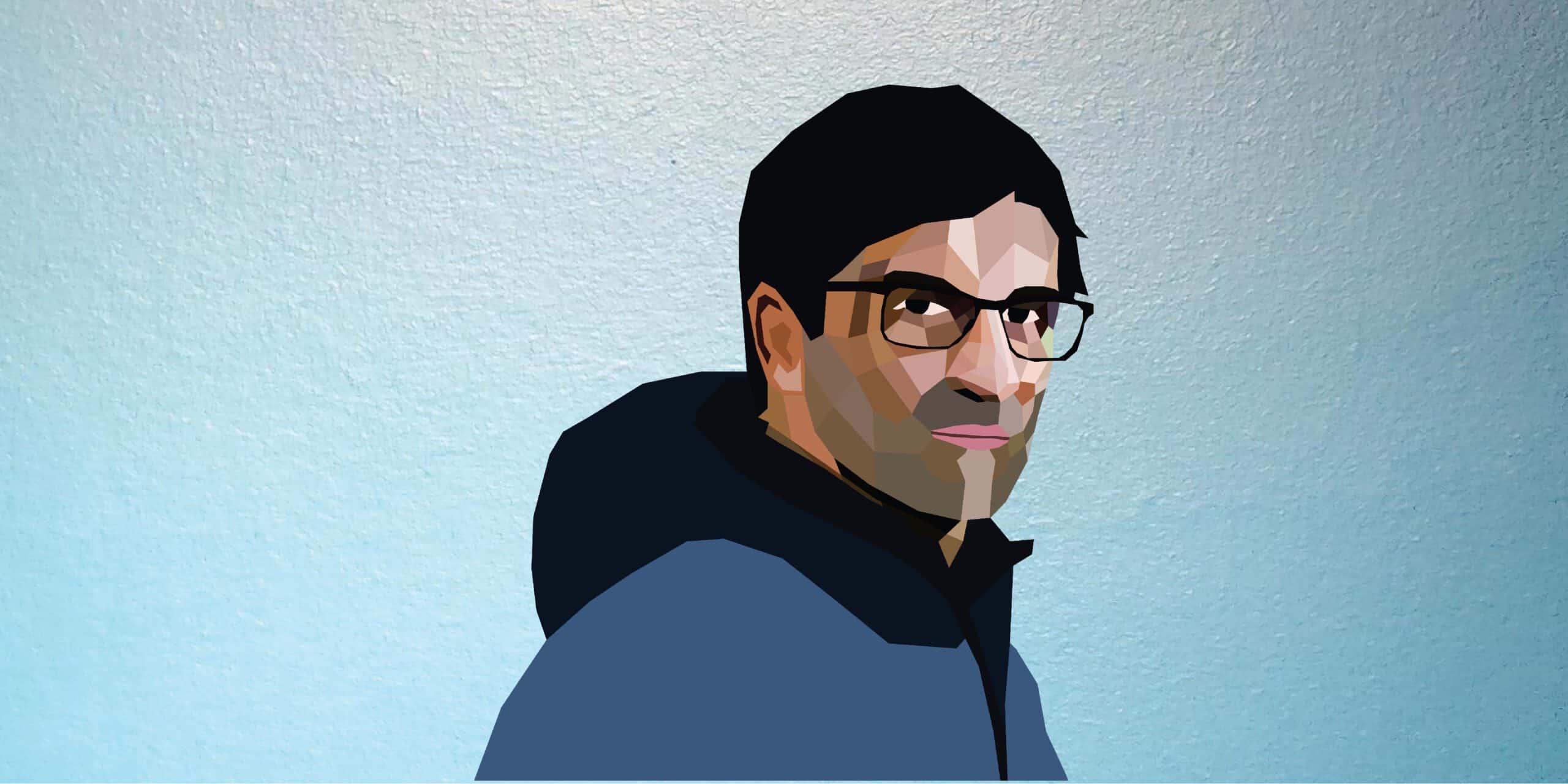



Comments